常用英语8种时态标志词
- 格式:docx
- 大小:20.18 KB
- 文档页数:2

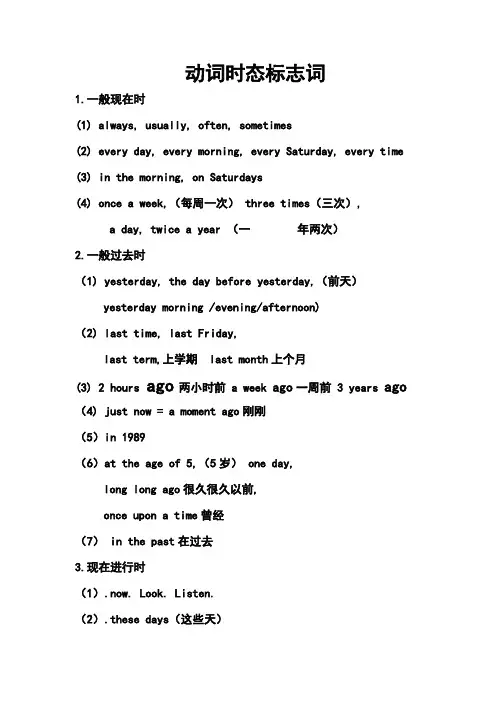
动词时态标志词1.一般现在时(1) always, usually, often, sometimes(2) every day, every morning, every Saturday, every time(3) in the morning, on Saturdays(4) once a week,(每周一次) three times(三次),a day, twice a year (一年两次)2.一般过去时(1) yesterday, the day before yesterday,(前天)yesterday morning /evening/afternoon)(2) last time, last Friday,last term,上学期 last month上个月(3) 2 hours ago两小时前 a week ago一周前 3 years ago (4) just now = a moment ago刚刚(5)in 1989(6)at the age of 5,(5岁) one day,long long ago很久很久以前,once upon a time曾经(7) in the past在过去3.现在进行时(1).now. Look. Listen.(2).these days(这些天)(3).at that time = at that moment. 此时此刻this time,ringht now(正在)4.过去进行时(1).at that time====at that moment.那时那刻this time ,yesterday evening(2)以when引导的谓语动词是一般过去时的时间状语5.一般将来时(1) tomorrow, in the future在将来 some day不久的一天the day after tomorrow,后天tomorrow morning /evening/ afternoon(2) next time, next Friday, next term, next month(3) in two weeks/monthes/years两周/月/年后(4) soon = right away = at once不久(5) by the end of + 将来时间直到。
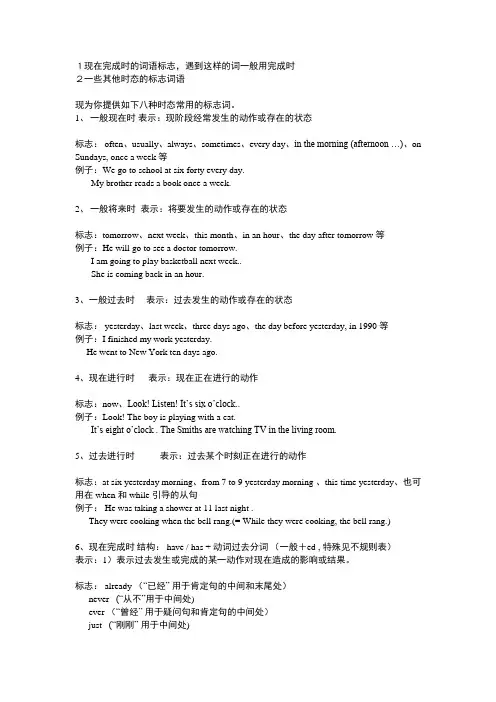
1现在完成时的词语标志,遇到这样的词一般用完成时2一些其他时态的标志词语现为你提供如下八种时态常用的标志词。
1、一般现在时表示:现阶段经常发生的动作或存在的状态标志: often、usually、always、sometimes、every day、in the morning (afternoon …)、on Sundays, once a week等例子:We go to school at six forty every day.My brother reads a book once a week.2、一般将来时表示:将要发生的动作或存在的状态标志:tomorrow、next week、this month、in an hour、the day after tomorrow 等例子:He will go to see a doctor tomorrow.I am going to play basketball next week..She is coming back in an hour.3、一般过去时表示:过去发生的动作或存在的状态标志: yesterday、last week、three days ago、the day before yesterday, in 1990 等例子:I finished my work yesterday.He went to New York ten days ago.4、现在进行时表示:现在正在进行的动作标志:now、Look! Listen! It’s six o’clock..例子:Look! The boy is playing with a cat.It’s eight o’clock . The Smiths are watching TV in the living room.5、过去进行时表示:过去某个时刻正在进行的动作标志:at six yesterday morning、from 7 to 9 yesterday morning 、this time yesterday、也可用在when和while引导的从句例子: He was taking a shower at 11 last night .They were cooking when the bell rang.(= While they were cooking, the bell rang.)6、现在完成时结构: have / has + 动词过去分词(一般+ed , 特殊见不规则表)表示:1)表示过去发生或完成的某一动作对现在造成的影响或结果。

山大之星培训中心英语八种时态归纳复习英语八种时态归纳复习一、一般现在时:概念:经常、反复发生的动作或行为及现在的某种状况。
时间状语:always, usually, often, sometimes, every week (day, year, month…), once a week, on Sundays, etc.二、一般过去时:概念:过去某个时间里发生的动作或状态;过去习惯性、经常性的动作、行为。
时间状语:ago, yesterday, the day before yesterday, last week(year, night, month…), in 1989, just now, at the age of 5, one day, long long ago, once upon a time, etc.三、现在进行时:概念:表示现阶段或说话时正在进行的动作及行为。
时间状语:now, at this time, these days, etc.四、过去进行时:概念:表示过去某段时间或某一时刻正在发生或进行的行为或动作。
时间状语:at this time yesterday, at that time或以when引导的谓语动词是一般过去时的时间状语等。
五、现在完成时:概念:过去发生或已经完成的动作对现在造成的影响或结果,或从过去已经开始,持续到现在的动作或状态。
时间状语:recently, lately, in the past few years, already, yet, just, ever, never ,so far, for +一段时间,since+过去的时间或过去时从句.或this year alone"今年以来",these five years alone"这五年以来",in the last ten years "在过去的十年中"等.etc.六、过去完成时:概念:以过去某个时间为标准,在此以前发生的动作或行为,或在过去某动作之前完成的行为,即“过去的过去”。
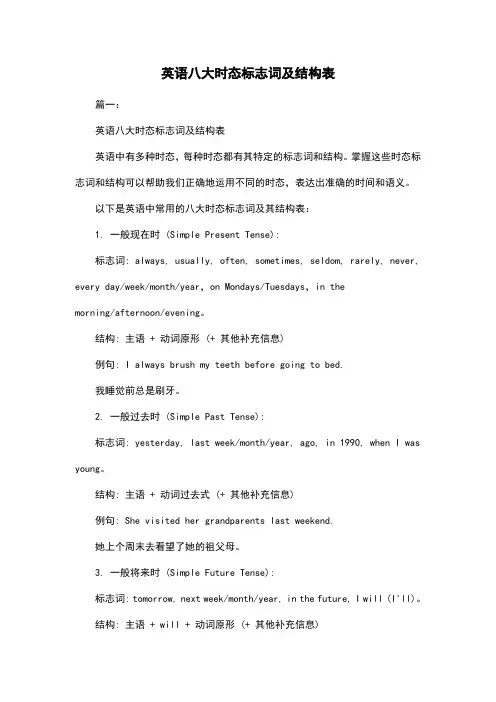
英语八大时态标志词及结构表篇一:英语八大时态标志词及结构表英语中有多种时态,每种时态都有其特定的标志词和结构。
掌握这些时态标志词和结构可以帮助我们正确地运用不同的时态,表达出准确的时间和语义。
以下是英语中常用的八大时态标志词及其结构表:1. 一般现在时 (Simple Present Tense):标志词: always, usually, often, sometimes, seldom, rarely, never, every day/week/month/year,on Mondays/Tuesdays,in themorning/afternoon/evening。
结构: 主语 + 动词原形 (+ 其他补充信息)例句: I always brush my teeth before going to bed.我睡觉前总是刷牙。
2. 一般过去时 (Simple Past Tense):标志词: yesterday, last week/month/year, ago, in 1990, when I was young。
结构: 主语 + 动词过去式 (+ 其他补充信息)例句: She visited her grandparents last weekend.她上个周末去看望了她的祖父母。
3. 一般将来时 (Simple Future Tense):标志词: tomorrow, next week/month/year, in the future, I will (I'll)。
结构: 主语 + will + 动词原形 (+ 其他补充信息)例句: We will go shopping tomorrow.我们明天去购物。
4. 现在进行时 (Present Continuous Tense):标志词: now, at the moment, currently, right now, look!。

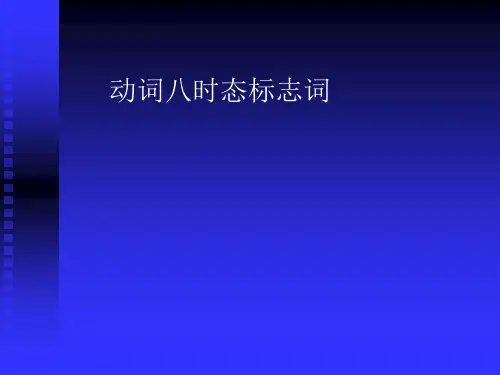
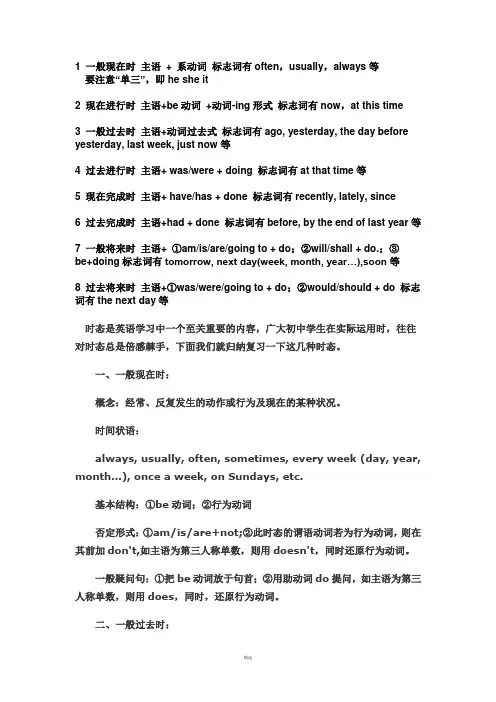
1 一般现在时主语+ 系动词标志词有often,usually,always等要注意“单三”,即he she it2 现在进行时主语+be动词+动词-ing形式标志词有now,at this time3 一般过去时主语+动词过去式标志词有ago, yesterday, the day before yesterday, last week, just now等4 过去进行时主语+ was/were + doing 标志词有at that time等5 现在完成时主语+ have/has + done 标志词有recently, lately, since6 过去完成时主语+had + done 标志词有before, by the end of last year等7 一般将来时主语+ ①am/is/are/going to + do;②will/shall + do.;③be+doing标志词有tomorrow, next day(week, month, year…),soon等8 过去将来时主语+①was/were/going to + do;②would/should + do 标志词有the next day等时态是英语学习中一个至关重要的内容,广大初中学生在实际运用时,往往对时态总是倍感棘手,下面我们就归纳复习一下这几种时态。
一、一般现在时:概念:经常、反复发生的动作或行为及现在的某种状况。
时间状语:always, usually, often, sometimes, every week (day, year, month…), once a week, on Sundays, etc.基本结构:①be动词;②行为动词否定形式:①am/is/are+not;②此时态的谓语动词若为行为动词,则在其前加don't,如主语为第三人称单数,则用doesn't,同时还原行为动词。
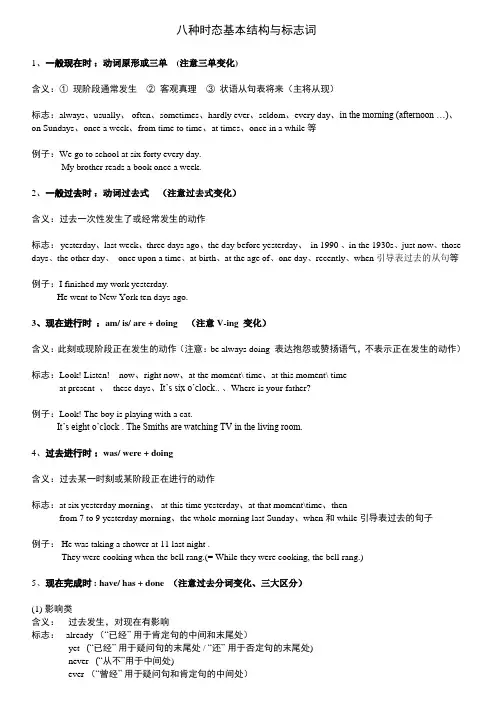
八种时态基本结构与标志词1、一般现在时:动词原形或三单(注意三单变化)含义:①现阶段通常发生②客观真理③状语从句表将来(主将从现)标志:always、usually、 often、sometimes、hardly ever、seldom、every day、in the morning (afternoon …)、on Sundays、once a week、from time to time、at times、once in a while等例子:We go to school at six forty every day.My brother reads a book once a week.2、一般过去时:动词过去式(注意过去式变化)含义:过去一次性发生了或经常发生的动作标志: yesterday、last week、three days ago、the day before yesterday、in 1990 、in the 1930s、just now、those days、the other day、once upon a time、at birth、at the age of、one day、recently、when引导表过去的从句等例子:I finished my work yesterday.He went to New York ten days ago.3、现在进行时:am/ is/ are + doing (注意V-ing 变化)含义:此刻或现阶段正在发生的动作(注意:be always doing 表达抱怨或赞扬语气,不表示正在发生的动作)标志:Look! Listen! now、right now、at the moment\ time、at this moment\ timeat present 、these days、It’s six o’clock..、Where is your father?例子:Look! The boy is playing with a cat.It’s eight o’clock . The Smiths are watching TV in the living room.4、过去进行时:was/ were + doing含义:过去某一时刻或某阶段正在进行的动作标志:at six yesterday morning、 at this time yesterday、at that moment\time、thenfrom 7 to 9 yesterday morning、the whole morning last Sunday、when和while引导表过去的句子例子: He was taking a shower at 11 last night .They were cooking when the bell rang.(= While they were cooking, the bell rang.)5、现在完成时 : have/ has + done (注意过去分词变化、三大区分)(1)影响类含义:过去发生,对现在有影响标志:already (“已经”用于肯定句的中间和末尾处)yet (“已经”用于疑问句的末尾处 / “还”用于否定句的末尾处)never (“从不”用于中间处)ever (“曾经”用于疑问句和肯定句的中间处)just (“刚刚”用于中间处)before ("之前" 用于句尾)once/ twice/ three times...例子:I have just cleaned my clothes. 我刚洗过衣服。
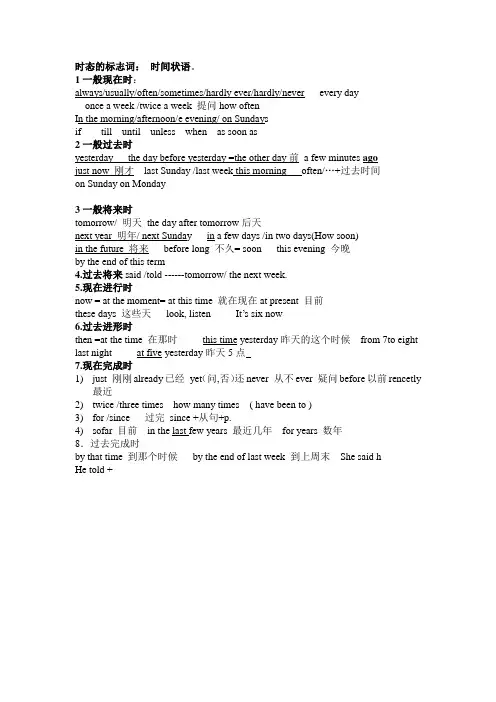
时态的标志词:时间状语。
1一般现在时:always/usually/often/sometimes/hardly ever/hardly/never every dayonce a week /twice a week 提问how oftenIn the morning/afternoon/e evening/ on Sundaysif till until unless when as soon as2一般过去时yesterday the day before yesterday =the other day前a few minutes agojust now 刚才last Sunday /last week this morning often/…+过去时间on Sunday on Monday3一般将来时tomorrow/ 明天the day after tomorrow后天next year 明年/ next Sunday in a few days /in two days(How soon)in the future 将来before long 不久= soon this evening 今晚by the end of this term4.过去将来said /told ------tomorrow/ the next week.5.现在进行时now = at the moment= at this time 就在现在at present 目前these days 这些天look, listen It’s six now6.过去进形时then =at the time 在那时this time yesterday昨天的这个时候from 7to eight last night at five yesterday昨天5点7.现在完成时1)just 刚刚already已经yet(问,否)还never 从不ever 疑问before以前rencetly最近2)twice /three times how many times ( have been to )3)for /since 过完since +从句+p.4)sofar 目前in the last few years 最近几年for years 数年8.过去完成时by that time 到那个时候by the end of last week 到上周末She said hHe told +3.现在进行时:am/is/are working 4过去进行时:was/were working5.一般将来时will/shall/is,am ,are going to work6.过去将来时:would work/was/were going to7.现在完成时has/have+worked 8过去完成时had worked现在进行完成时:has/have been workinghall/is,am ,are going to work过去进行时:was/were workingShall I/we… ? shall 只能与I/we 连用被动语态重点考:一般现在:am/is /are done一般过去:was/were done一般将来:will be+done1._____ you______ (clean) the room now? No, I____2._______ you ____(clean) the room every day.? Yes ,______3.I’m _________ (watch)4.Is Jim _______ (do) his homework? Yes,_____.5.Lilly and Lucy __________-(clean).now6.She ___________ (not read) now. She _________(do) her homework7.Loo k!They _________ (take)photos .8.Look !The cat _________(run) up the tree9.Listen!Who_________ (sing).10.Listen!The birds_________(sing)11.It’s six o’clock now We ________(have) dinner at home.12._____your father and mother _______(read)books/yes , ______13.Your friends ________(wait) for you.now.情态动词should /can / may / must +doneI. 句型转换1. The children had a good time in the park.否定句:__________________________________________一般疑问句:________________________________________对划线部分提问:____________________________________2. There were about nine hundred people at the concert.(音乐会) 否定句:__________________________________________一般疑问句:________________________________________ 对划线部分提问:____________________________________ 3. There was only one problem.否定句:__________________________________________ 一般疑问句:________________________________________ 肯定/否定回答:____________________________________ 4. Ann did her homework yesterday evening.否定句:__________________________________________ 一般疑问句:________________________________________ 对划线部分提问:____________________________________ 5. Last week I read an English book.否定句:__________________________________________ 一般疑问句:________________________________________ 肯定/否定回答:____________________________________ 对划线部分提问:____________________________________ 6. My brother was in the park just now.否定句:__________________________________________ 一般疑问句:________________________________________ 肯定/否定回答:____________________________________ 对划线部分提问:____________________________________7. She had some bread for lunch today.否定句:__________________________________________一般疑问句:________________________________________肯定/否定回答:____________________________________对划线部分提问:____________________________________8. They read English last night.否定句:__________________________________________一般疑问句:________________________________________肯定/否定回答:____________________________________对划线部分提问:____________________________________、写出下列动词的三单现、过去式和现在分词go ______ _______ _______ enjoy _______ _______ ________buy ______ ______ _______ eat______ _______ _______get _______ _______ _______ walk ________ _______ ________take______ ______ ______ dance_______ ________ _______write _______ ______ ______ run______ _______ _______swim_______ _______ _______ find _______ _______ _______begin______ ______ ______ eat ______ _______ ______play ______ ______ _______ study ______ ______ ________III. 用所给词的适当形式填空。
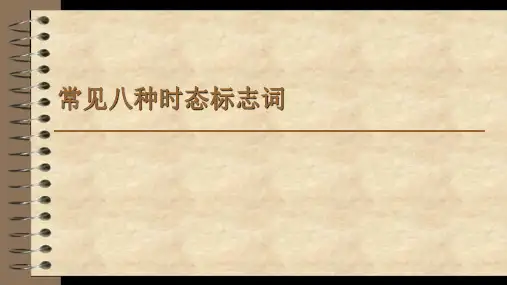
中高考英语常考8种英语时态的标志词【一般现在时】usually 通常often 经常always 总是sometimes 有时every day 每天every time 每一次in the morning 早晨every morning 每天早晨on Saturdays 星期天once a week 一周一次three times a day一天三次twice a year 一年两次every Sunday每个星期日【一般过去时】yesterday昨天the day before yesterday前天yesterday morning昨天早上last time上一次last Friday上星期五last term上学期last year去年一段时间+ago多久以前just now刚刚a moment ago刚刚in19901990atthe age of6六岁的时候one day有一天long long ago很久以前once upon a time从前in the past过去【一般将来时】tomorrow明天the day after tomorrow后天tomorrow morning明天早上next time下一次next Friday下个星期五next term下个学期next month下个月in+一段时间多久以后in+一段时间’s+timesoon=right away=at once by the end of+将来时间【现在进行时】now 现在look 看listen 听at this time 此时at this moment 此刻at present 现在these days 这些天this week 这周yesterday evening昨天晚上【现在完成时】already早已,已经,先前yet还,但是,已经just刚才never从不ever曾经before以前up to now目前为止for+一段时间since+过去某一时间【过去进行时】at that timeat that moment【过去将来时】the following month the next timethe next Fridaythe next term【过去完成时】(1) by +过去时间点by the timeby thenby last yearby the end of last year (2) before+过去时间点(3) up till +过去时间点up till thenup until last morning。
英语语法中有多种时态,用于表示动作的时间、状态的持续性等不同信息。
以下是英语中的8种常见时态,以及它们的主要用途和例句:1. **一般现在时(Simple Present)**:- 主要用于表示通常、经常或普遍的情况、事实或习惯。
- 构造:主语+ 动词的原形(第三人称单数要加-s)。
- 例句:I work at a company.(我在一家公司工作。
)2. **一般过去时(Simple Past)**:- 主要用于表示过去某一具体时间的动作或事件。
- 构造:主语+ 动词的过去式。
- 例句:She visited Paris last summer.(她去年夏天去了巴黎。
)3. **一般将来时(Simple Future)**:- 主要用于表示将来的意图、计划或预测。
- 构造:主语+ 将来时标志词(will/shall)+ 动词的原形。
- 例句:I will call you tomorrow.(我明天会给你打电话。
)4. **现在进行时(Present Continuous)**:- 主要用于表示现在正在进行的动作。
- 构造:主语+ am/is/are + 动词的现在分词。
- 例句:They are studying for the exam.(他们正在为考试而学习。
)5. **过去进行时(Past Continuous)**:- 主要用于表示过去某一时刻正在进行的动作。
- 构造:主语+ was/were + 动词的现在分词。
- 例句:I was watching TV when you called.(你打电话时,我正在看电视。
)6. **将来进行时(Future Continuous)**:- 主要用于表示将来某一时刻正在进行的动作。
- 构造:主语+ will be + 动词的现在分词。
- 例句:At 3 PM tomorrow, I will be working.(明天下午3点,我将在工作。
英语八大时态标志词及结构表篇一:英语八大时态标志词及结构表正文:英语中存在八大时态,分别是:过去时、现在时、将来时、过去将来时、现在进行时、将来进行时、过去进行时、现在完成时和未来完成时。
这些时态的不同表达方式和用法,对于英语写作和口语表达都是非常重要的。
本文将介绍这些时态的标志词和结构表,帮助学习者更好地理解和掌握这些时态。
1. 过去时过去时通常用“态”或“ed”表示,表示动作或状态发生在过去。
标志词包括:- was(过去分词):表示动作或状态发生在过去某个时间。
- are(过去分词):表示动作或状态发生在过去。
- was/are(过去分词):表示动作或状态发生在过去的某个时刻。
结构表:| 主语 | 谓语动词 | 时态标志词 || --- | --- | --- || I | I was | was/are || you | you are | are || he/she/it | he/she/it was | was/are || we | we are | are || they | they were | were/are |2. 现在时现在时通常用“态”或“ing”表示,表示动作或状态现在正在进行。
标志词包括:- am/is(现在分词):表示动作或状态现在正在进行。
- are(现在分词):表示动作或状态现在正在进行。
- was/are(现在分词):表示动作或状态现在正在进行。
结构表:| 主语 | 谓语动词 | 时态标志词 || --- | --- | --- || I | I am | am/is || you | you are | are || he/she/it | he/she/it is | is/are || we | we are | are || they | they are | are |3. 将来时将来时通常用“态”或“ing”表示,表示动作或状态将来会发生。
标志词包括:- will(将来分词):表示动作或状态将来会发生。
常用英语8种时态这64个标志词就够了一般现在时
always,ususlly,often,sometimes
never ,seldom很少(否定词)
every day/week/month/year/morning/evening/night
each day/week/month/year/morning/evening/night
once a week每周一次,
twice a month每月两次,
three times a year一年三次
in the morning 早晨
on Saturdays 周六
every morning 每天早晨
every Saturday 每个周六
一般过去时
yesterday昨天
the day before yesterday前天,
two days ago两天前
last day/night/week/month/year 昨天/夜;上周/月;去年
in 1990 在1990年
just now刚才
at the age of five五岁时
once upon a time 从前
in the past 过去
a moment ago 刚刚
long long ago 很久以前
in 1988 1988年
last Friday 上周五
一般将来时
tomorrow 明天
the day after tomorrow 后天
tomorrow morning 明天早上
next time 下次
next Friday/term/month/year
in+一段时间
soon/right away
in the future
现在进行时
now 现在
look 看
listen 听
at this time/moment此时
these days 这些天
at present 现在
现在完成时
already/yet
just
never
ever
for+一段时间
since+时间一点
so far/up to now 到目前为止
in the past three years 在过去3年里过去完成时
by+过去时间点
by the time
by then
by the end of last year
before+过去时间点
up till+过去时间点
up till then
过去进行时
at that time
at that moment
yesterday evening
过去将来时
the following month
the next time
the next friday
the next term。